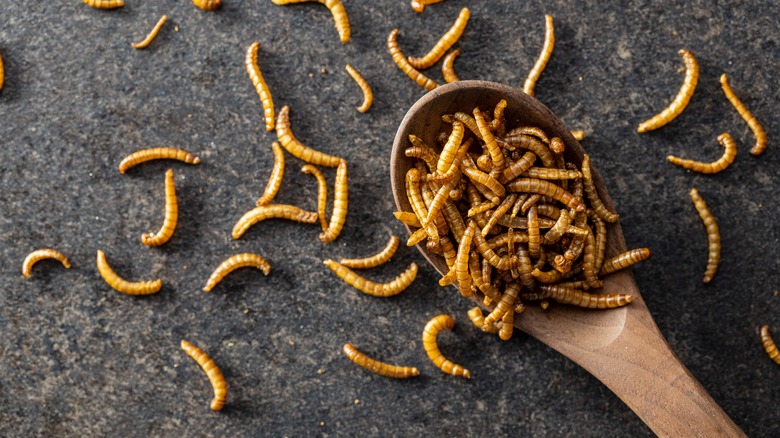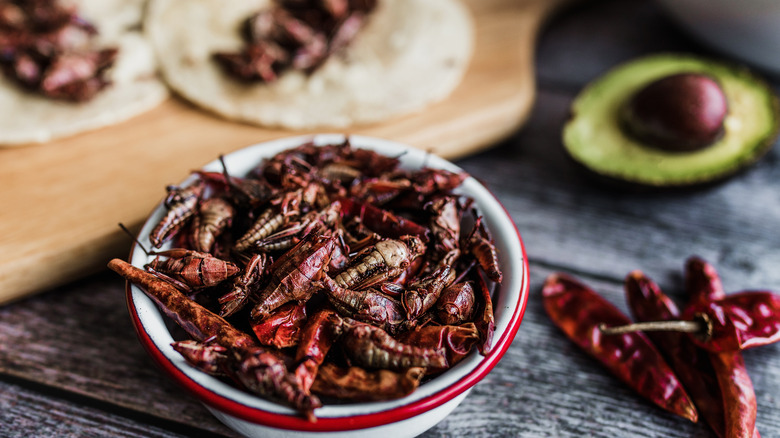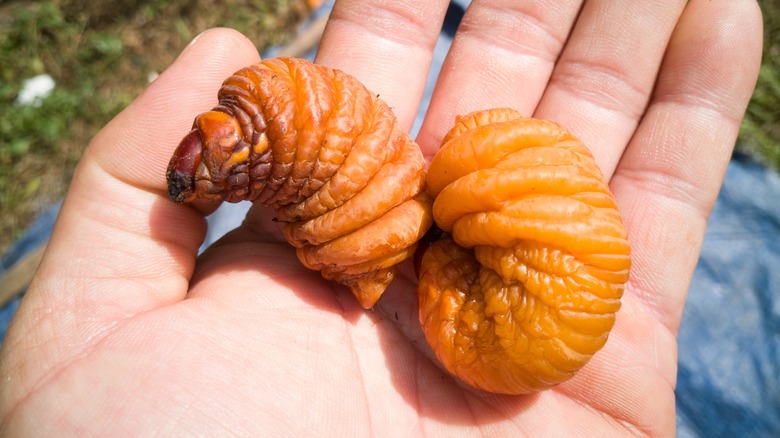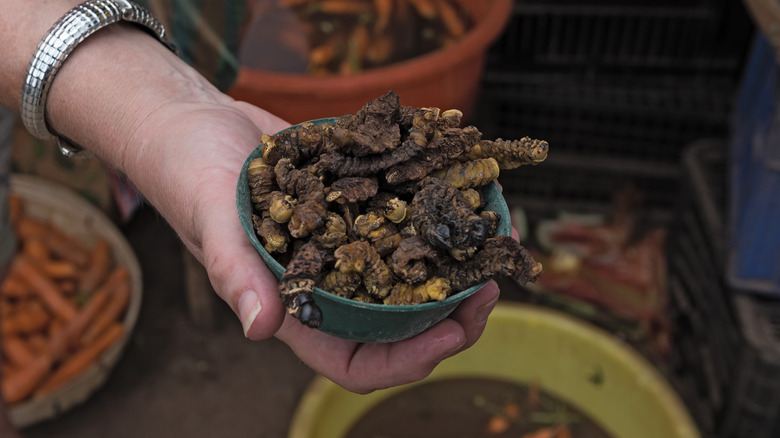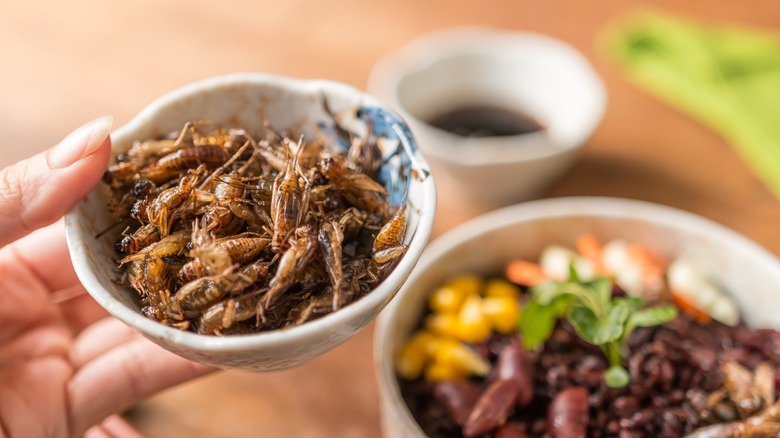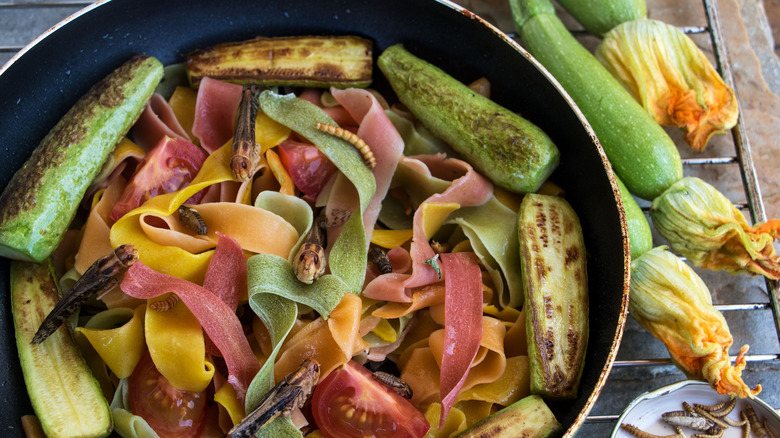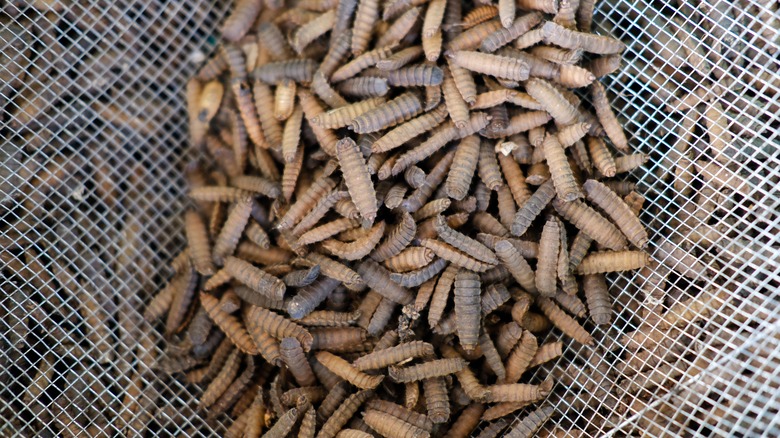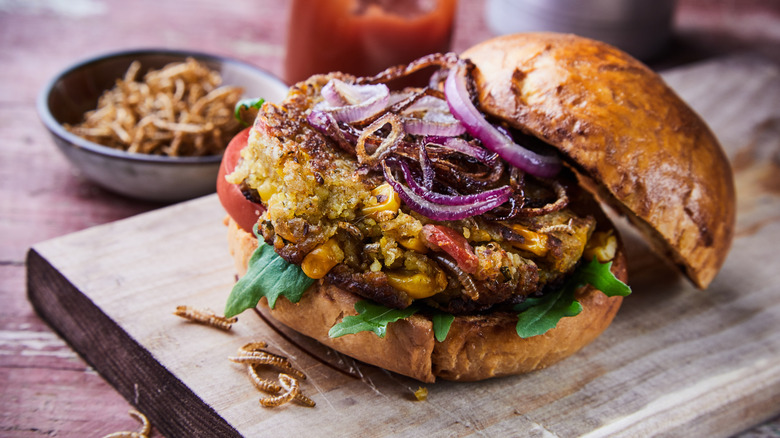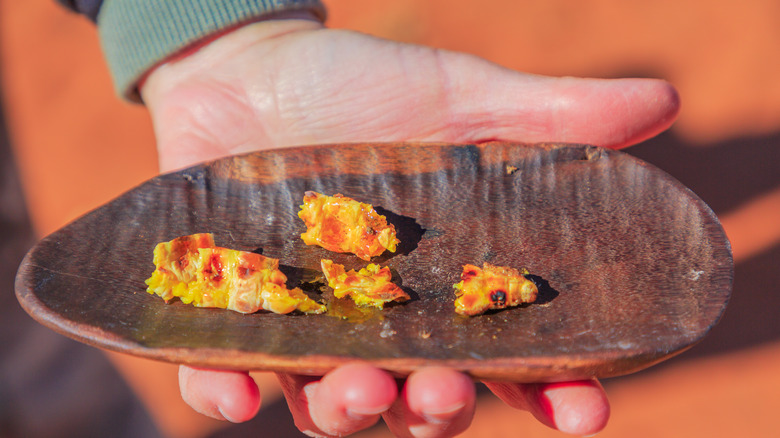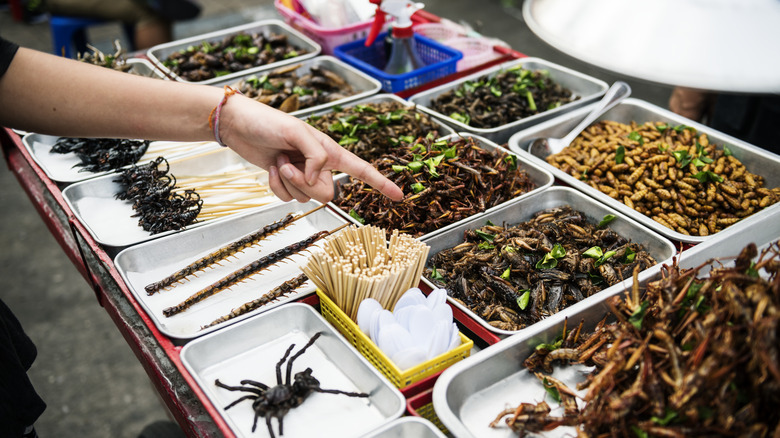11 Bug And Insect-Eating Practices Across The Globe
We've all heard statistics about the average number of spiders we're said to swallow while sleeping. The thing is, eating bugs or insects, even if unintentional, is not a new practice, nor is it one left to those at the edges of civilization or desperation. Eating insects, a practice known as entomophagy, is an ancient and increasingly common practice that takes shape in many different forms worldwide.
The sustainability behind entomophagy cannot be denied. In water usage alone, to create one pound of cricket protein requires just one gallon of water, compared to the roughly 1,850 gallons to produce the equivalent amount of beef.
Remarkably, crickets seem to be the "gateway bug" to those still warming their minds and palates to the idea of insect-eating. Modern-day companies have started making cricket-infused powders, crackers, and pasta to help those who are squeamish about the concept disassociate from the shape of what they are consuming. It could be considered a similar disassociation to how meat, poultry, and fish are sold in U.S. supermarkets, often pre-cut and packaged to remove indications of the once-living animal. Fancy learning more? Here are just some of the entomophagy practices enjoyed around the world.
Mexico
According to Lonely Planet, Mexico has the world's highest number of edible insects. It also is home to many cultures and indigenous communities that have used insects in their cooking for thousands of years. Perhaps it's time the U.S. looks more closely and takes inspiration from Mexican cuisine beyond tacos, especially when it comes to sustainable and delicious ways of incorporating these high-protein ingredients into daily life.
The list of edible insects and bugs is far longer than is possible to name here. The list includes guanos (grubs), jumiles (stink bugs), chicatanas (giant winged ants), chapulines (grasshoppers), and many, many more.
Gusanos are perhaps the insects that those living outside of Mexico will be familiar with. They are the grubs at the bottom of your favorite bottle of mezcal, placed there for their natural filtration abilities. They are said to be eaten as aphrodisiacs even when the alcohol is removed. They have been a high-protein Indigenous culinary tradition long before Spanish colonization.
Chapulines or grasshoppers are one of the most widely consumed insects in the country. Dried or fried, they make for the most delicious bar or road trip snack and can be found with various seasonings. However, you can find insects in some of Mexico City's top restaurants, including Pujol, so it's not just reserved for street food or snacks.
Ghana
In 2015, with the help Aspire Food Group — an organization dedicated to supporting insect farm technology and innovation — Ghana became the first of two countries to undertake the processes of commercially farming palm weevils. They're insects rich in iron, and the project was launched by local farmers as an additional source of income as well as the growth of a sustainable protein source.
While insect-eating of a wide variety has long since been a part of Ghana's rural food culture, Kyei Manu, a local cassava and sheep farmer-turned-weevil producer, aims to help incorporate this same practice in more city settings. The hope is to increase health, access to nourishment, and work to disassociate the tradition with assumptions of poverty, as Kwame Afreh-Nuamah, professor of entomophagy at the University of Ghana, tells The Guardian.
When Aspire's focus turned to the pet food industry, one of its founders, Shobhita Soor, decided to carry on with the original mission, founding Legendary Foods in 2020. The business sells a variety of fresh and frozen larvae in the interest of providing residents of Ghana with a sustainable, shelf-stable alternative to animal proteins and creating an opportunity for entomophagy for those unfamiliar with the practice, such as those growing up in the city (via How We Made It In Africa).
South Africa
The consumption of insects in various forms and traditions is foundational among various Indigenous groups across the continent of Africa as a whole. The practice of insect-eating, however, is reported to be declining in areas that have adopted more Western food sources, amongst younger generations, and areas where access to the insects has decreased, either due to the rise in population like in cities or due to climate change, according to a 2021 article published in the journal Insects.
The fear is that as the practice of insect eating declines, not only is the cultural practice lost for future generations, but also the indigenous knowledge that has accompanied the tradition.
However, despite the validity of these fears, a 2021 survey conducted by the authors of the article found that the practice of insect-eating is still alive and well in various regions of South Africa. That includes 95% of those who responded to the survey living in Limpopo still consuming mope worms and termites among other varieties. More tech-food iterations of insect-eating are popping up as well, like Gourmet Grubb, launched in 2017, which uses black fly larvae milk in treats like ice cream to cater to and encourage more western-leaning food habits.
Japan
Food writer, podcast producer, and author of the graphic novel "MEAL: Adventures in Entomophagy," Soleil Ho explains that entomophagy is far from a new practice in Japan (via Splendid Table). Raising wasps for food in Kushihara, Japan, is "as casual as keeping an apple tree in the yard."
Wasps and many other species are consumed, including giant hornets (used in creating shochu) and their larvae, whose texture, Ho notes, compares to shrimp. In fact, this practice is so deeply rooted that it's celebrated annually with the Kushihara Hebe Festival, dedicated to celebrating all things wasp (via BBC Travel). It is an event that takes many months of preparation and incorporates a variety of dishes and cooking techniques to bring out and enjoy every aspect the wasp has to offer.
Though these traditions are alive and well in Japan, so is the edible insect industry, with many new companies offering insect powders, flours, and infused snacks. Such is the case for the newly launched food technology company Gryllus Co. The company's spokesperson Fumiya Aokubu told DW their cricket powder could be used in all kinds of cooking, from biscuits to curries.
Not just for annual festivals or powders, insects are also sold dried in vending machines, roasted, and sold as street food snacks, on tasting menus at restaurants, in specialist stores, and just about everywhere in between.
America
Though many Americans may be more familiar with insect-eating dares like those on "Fear Factor," insect-eating is as indigenous to the Americas as some of the foods that end up on the Thanksgiving table (Jell-O salad not included).
According to Atlas Obscura, dozens of insect varieties were eaten regularly and used medicinally amongst Native American tribes throughout North America. Indigenous communities use insects and bugs from various species for their nutrition, medicinal properties, and taste throughout the country, devising specific harvest systems much like other wild and foraged foods at that time.
Grasshoppers were particularly prevalent in the plains, where they were gathered through a comprehensive community process that involved encircling bushes to drive the insects into concentrated areas for collection. Meanwhile, tribal communities out west would harvest caterpillars in multitudes via the construction of walls around the trees they nested, then driven out by smoke. Cicadas were fried in pork fat, salted and pickled, or ground up and baked into loaves of bread or pies. Cornworms and grubs, meanwhile, were roasted, and ants were used for a bright citrus flavor. Bugs were a normal, edible part of everyday life.
Though many of these practices have since died out, largely due to the dominance of the food practices by European settlers, insects were once a foundational food source in the U.S. and should be recognized as such.
Brazil
Amongst many things, Brazil is home to Maria Tatuyo, a 22-year-old darling of TikTok who goes by Cunhaporanga. Cunhaporanga is known for showcasing her daily life as an Indigenous woman, including the consumption of insects, larvae, ants, and more. It is nothing new to her, her family, or those who live within her community, though that might not be the case for people who account for the 6.7 million views on the video of Tatuyo offering a bowl of larva to her family (via The Independent). Tatuyo is showcasing just some of the practices of the indigenous communities residing within Brazil who, despite accounting for roughly 13% of the country's population in 2015, are still underrepresented digitally.
This kind of reclamation isn't new in Brazil. In 2015, The Guardian reported many top chefs that had decisively put insects onto their tasting menus, including Alex Atala, whose restaurant D.O.M. is touted as one of the best in the world. One aim was to help dispel the notion that only the desperate or impoverished ate insects.
Alongside Atala's D.O.M. in São Paulo sits an array of startups, with a new food technology sector rapidly emerging, including Hakkuna, which sells protein bars made from flour infused with dried and ground crickets (via Pesquisa). The market, visibility, and acceptability of entomophagy in Brazil all continue to grow.
The Netherlands
According to NPR, the European Union earmarked up to $4 million dollars into insect-based protein sources in 2012, with the Netherlands deeply invested.
In a 2022 poll, one in five Dutch people who responded had already tried insects for themselves, with nearly 80% in agreement that food producers should include more insect-based proteins in their products (via Voedings Industry).
Kreca, an insect farm in operation for 35 years, raises 10 insect species mainly as a sustainable protein for pet food companies but also grows a species fit for human consumption. The farm was featured in 2015 in an episode of Andrew Zimmern's food travel show "Bizarre Foods" on the Travel Channel. The farm was one of four bug producers at the time of filming. Their insects have made their way into everyday convenience foods like pre-made nuggets and burgers sold in select supermarkets.
Jonas House, a lecturer at Wageningen University, discussed with his students whether or not the Dutch public would eventually accept fried grasshoppers and other insects, much like it did with Japanese sushi. It was uncommon at first, but eventually accepted and loved. While sushi has brought with it some of the cultural markers and experiences that are associated with the now revered cuisine, House says that insect-eating in Europe lacks the context of a popular, existing cuisine within the region, making it a more complex task to have the practice accepted into popular culture.
Norway
After the Food and Agriculture Organization of the United Nations released a report in 2014 singing the praises of edible insects, the making of insect-based products in countries and regions where it is not an indigenous practice increased significantly. However, it did take some time for the legal aspects to catch up with enthusiasm. The selling and use of edible insects within food products have only reached legal status within the Nordic countries of Norway, Denmark, and Finland in 2017, unlike other countries where the practice of entomophagy has been a part of the indigenous diet for hundreds of years.
This, along with issues such as public opinion and cost, has made progress slower and more tech-food-based. As in the Netherlands, without having the underpinning of a previously known cuisine with which to introduce insect consumption to the Norwegian public at large. Insect-derived protein also has heavy competition from tech-meat industries like Beyond Burgers, Impossible Foods, and other companies.
Methods of insect inclusion in countries like Norway include baking mealworm larvae into loaves of bread for increased protein, like the loaves produced by Norwegian retailer Meny (via European Supermarket Magazine). Other options which keep the bugs hidden from detection include tucking freeze-dried bugs into smoothies, burgers, and protein bars. Insect protein has also become widely popular as an alternative protein within pet foods (via Cargill). And two of Norway's Michelin-starred restaurants, Maemo and Nordic Food Lab, are incorporating wood ants — known for their citrus flavor — on their menus.
New Zealand
For many New Zealanders, the concept of eating insects isn't the kind of unfamiliar or controversial practice that would raise an eyebrow. According to a survey of 668 residents of the country conducted by the University of Auckland, 60% would be willing to try eating insects, with 59% already having done so at least once, if not regularly.
Entomophagy has long been practiced by the Māori communities of New Zealand, the first inhabitants of the island who arrived from the Eastern Pacific Islands in the 1300s. Huhu grubs are still enjoyed, eaten raw for their rich chicken-like flavor.
As with other countries on this list, New Zealand also has companies like Eat Crawlers, established in 2013, that are working to modernize the sustainable practice of entomophagy by including insects in household staples like flour, as well as convenient snacks like popcorn, chocolate-covered treats, and even lollipops.
Thailand
Street foods, snacks, and night markets are foundational to Thailand's cuisine and culture. Insects are often a part of this practice, too, whether skewered and grilled, deep fried in a lashing of soy or fish sauce, sunk into coconut milk-based curries, or otherwise prepared. In the city of Phuket, there are many ways to get your fill as you eat throughout the city, as you can try some of the more typical insects like grasshoppers, red ants, silkworms, and crickets. Per Import Foods, a snack of seasoned and deep-fried crickets, known as jing leed, is a very typical and thoroughly enjoyed snack, especially when accompanied by a beer or cold drink.
However, insects are not just found in street food-based snacks alone. They also have a presence within Thailand's fine dining and are not tied to just one particular economic group, but rather a part of the culture regardless of financial status. As noted by Channel News Asia, Bangkok-based chef Surest Buttama includes silkworms, grasshoppers, and bamboo caterpillars on his tasting menu, as do many others like Chef Gong, a man known for his incorporation of edible insects within fine dining.
"In our restaurant, we strive to bring insects to be made into food for people to feel, eat and taste, and to make them open their minds in order to prepare themselves for the near future," Gong tells CNA.
Across Europe
Brussels-based company Yuma uses cricket flour to produce crispbreads and crackers — the perfect accompaniment to your next cheese or charcuterie board. Yuma founder Gabrielle Wittock tells The Parliament how she likes to switch up her usual at-home movie snacks from crisps to whole dried crickets, keeping the satisfying crunch but increasing nutrition. Wittock is hoping her company, which uses the nutty and smoky flavor profile of crickets and the bright lemony flavor of ants in their products, will help ease entry into the wide and wonderful world of entomophagy, which she, along with many others, see as a way to reduce food insecurity and the impact of climate change.
Meanwhile, further south in Parma, Italy, the European Food Safety Authority is working to implement all of the rules and regulations to help bring more insect-based food technology to the masses, a relatively new practice for many parts of this region. The yellow mealworm was given the green light in 2021, meaning it may now be the next big bug to make its way into food products across Europe, with the migratory locust and the house cricket now on the precipice of their own 15 minutes of fame.
